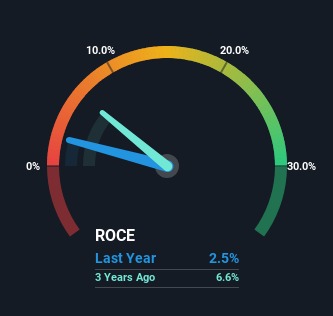- Taiwan
- /
- Auto Components
- /
- TWSE:2239
There Are Reasons To Feel Uneasy About Cayman Engley Industrial's (TWSE:2239) Returns On Capital

What trends should we look for it we want to identify stocks that can multiply in value over the long term? Firstly, we'll want to see a proven return on capital employed (ROCE) that is increasing, and secondly, an expanding base of capital employed. If you see this, it typically means it's a company with a great business model and plenty of profitable reinvestment opportunities. However, after investigating Cayman Engley Industrial (TWSE:2239), we don't think it's current trends fit the mold of a multi-bagger.
Understanding Return On Capital Employed (ROCE)
If you haven't worked with ROCE before, it measures the 'return' (pre-tax profit) a company generates from capital employed in its business. To calculate this metric for Cayman Engley Industrial, this is the formula:
Return on Capital Employed = Earnings Before Interest and Tax (EBIT) ÷ (Total Assets - Current Liabilities)
0.025 = NT$548m ÷ (NT$38b - NT$15b) (Based on the trailing twelve months to June 2024).
So, Cayman Engley Industrial has an ROCE of 2.5%. Ultimately, that's a low return and it under-performs the Auto Components industry average of 8.8%.
Check out our latest analysis for Cayman Engley Industrial

Historical performance is a great place to start when researching a stock so above you can see the gauge for Cayman Engley Industrial's ROCE against it's prior returns. If you want to delve into the historical earnings , check out these free graphs detailing revenue and cash flow performance of Cayman Engley Industrial.
What The Trend Of ROCE Can Tell Us
On the surface, the trend of ROCE at Cayman Engley Industrial doesn't inspire confidence. To be more specific, ROCE has fallen from 9.1% over the last five years. On the other hand, the company has been employing more capital without a corresponding improvement in sales in the last year, which could suggest these investments are longer term plays. It may take some time before the company starts to see any change in earnings from these investments.
On a separate but related note, it's important to know that Cayman Engley Industrial has a current liabilities to total assets ratio of 41%, which we'd consider pretty high. This can bring about some risks because the company is basically operating with a rather large reliance on its suppliers or other sorts of short-term creditors. While it's not necessarily a bad thing, it can be beneficial if this ratio is lower.
The Bottom Line On Cayman Engley Industrial's ROCE
Bringing it all together, while we're somewhat encouraged by Cayman Engley Industrial's reinvestment in its own business, we're aware that returns are shrinking. And in the last five years, the stock has given away 39% so the market doesn't look too hopeful on these trends strengthening any time soon. All in all, the inherent trends aren't typical of multi-baggers, so if that's what you're after, we think you might have more luck elsewhere.
On a final note, we've found 1 warning sign for Cayman Engley Industrial that we think you should be aware of.
While Cayman Engley Industrial isn't earning the highest return, check out this free list of companies that are earning high returns on equity with solid balance sheets.
New: AI Stock Screener & Alerts
Our new AI Stock Screener scans the market every day to uncover opportunities.
• Dividend Powerhouses (3%+ Yield)
• Undervalued Small Caps with Insider Buying
• High growth Tech and AI Companies
Or build your own from over 50 metrics.
Have feedback on this article? Concerned about the content? Get in touch with us directly. Alternatively, email editorial-team (at) simplywallst.com.
This article by Simply Wall St is general in nature. We provide commentary based on historical data and analyst forecasts only using an unbiased methodology and our articles are not intended to be financial advice. It does not constitute a recommendation to buy or sell any stock, and does not take account of your objectives, or your financial situation. We aim to bring you long-term focused analysis driven by fundamental data. Note that our analysis may not factor in the latest price-sensitive company announcements or qualitative material. Simply Wall St has no position in any stocks mentioned.
About TWSE:2239
Cayman Engley Industrial
Produces and sells automobile parts in China and internationally.
Mediocre balance sheet and slightly overvalued.
Market Insights
Community Narratives



